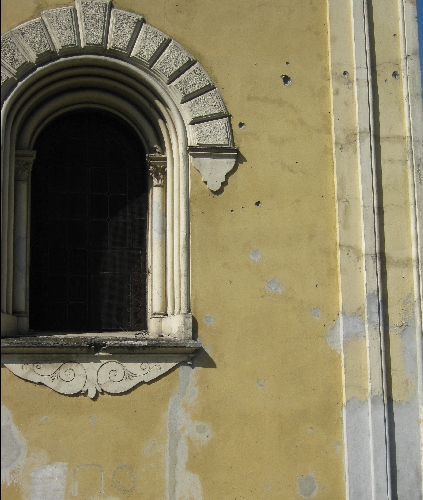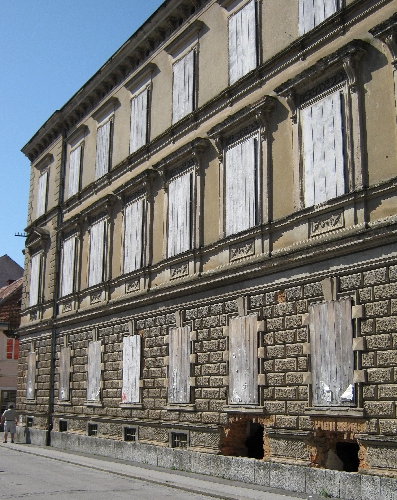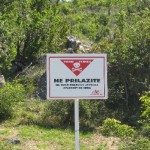
I’m sorry for the two week delay in posting my final piece about our time in Croatia. Since being back in Prague we’ve had a succession of visitors which has left little time for blogging!
We spent the night of Monday 20th July, our last in Croatia, in the town of Karlovac. Although considerable work has been done to repair the damage caused to buildings in Karlovac during the 1991-95 conflicts that followed the break-up of the former Yugoslavia, there still remains much to do.
The picture on the left is of part of the outside wall of a Roman Catholic Church attached to a Franciscan Monastery in the centre of the town. You can clearly see where holes caused by bullets and shrapnel have been filled in at lower levels whilst higher up, they remain un-repaired. Within the nave of this Church there were three modern stained-glass windows, presumably replacing ones damaged beyond repair during the fighting.


However, on another street corner not very far away, was this completely boarded up building that had clearly also been badly damaged in the conflict. The plaque on wall offered a partial explanation in Croatian, English and German. Until the ‘Croatian War of Independence’, it had served as an Orthodox Seminary and the administrative headquarters for the Orthodox Church in the surrounding area. The sign acknowledged that the building had been badly damaged in the war, but offered no further explanation as to why nothing has been done to repair it since.
The explanation unfortunately lies in the division between West and East that took place in the history of the Christian Church more than a thousand years ago. The division between Rome and Constantinople, between Roman Catholic and Orthodox which in turn is, the division between Roman Catholic Croat and Orthodox Serb. As with the area around Knin, when the Croatian army regained full control of Karlovac and the surrounding area, the vast majority of the Serb Orthodox population were either driven out or chose to flee. There is therefore now very little of the Serbian Orthodox Church functioning in Croatia so far as I could ascertain.
Much as we both enjoyed our time in Croatia, I did feel that this situation is a very bad reflection on Christianity as whole, regardless of different traditions. Christians ought to be at the heart of the important work of reconciliation. Instead, it seems that the respective Churches have allowed themselves to be far too closely associated with ardent nationalism.
The Roman Catholic Church is remarkably strong in Croatia. But I very much sense that this is in part due to its close association with the resurgence of the Croatian national identity which has shown very little concern for any minorities. Likewise, the Serbian Orthodox Church has been very much at the heart of the rise of Serbian nationalism with once more, very little concern for non-Serbs. This phenomenon is unfortunately not unique to the former Yugoslavia. The Russian Orthodox Church, seeking to recover from its suppression during the Soviet Communist era, is now very strongly associated with the rise of Russian nationalism and shows very little tolerance for anyone of a different persuasion.
Of course, these are the reflections of an outsider on a two week visit. There may be groups of Christians on either side of the divide who are working to bring about reconciliation. I hope there are! For whilst many buildings have been or are in process of being repaired, many lives have be irreparably damaged. The Christian Church, regardless of tradition, ought to be playing its part in bringing healing to the lives of those on both sides of the Croat-Serb divide, who have suffered so much as a result of this conflict.


Fascinating post, Ricky. I remember noticing at the time of the conflict how the various ethnic groups were also marked out and/or divided by religion. Yes, I agree, the entire Christian church should be about reconciliation with and acceptance of (not merely ‘tolerance’) of others. In France, there’ve been several wars of religion from the 12th century ‘Albigensian Crusade’ against the cathars in the Languedoc. It was launched by the King of France, whose remit didn’t then extend to the south, with the support of the Pope. Then came conflicts between Catholic and Protestant in the 16th-17th centuries. Henri IV put a (temporary) end to one phase with the Edict of Nantes, effectively protecting Protestants. When this was revoked (by Louis XIV in 1685), all hell broke loose again (with many Protestants fleeing to England – very good for England as they were almost entirely highly-skilled artisans!). In all these instances, the temporal ruler was the instigator for good or ill – not the church. Whoops, sorry: this is turning into a post! Apologies, Ricky; my excuse is that the original question’s such an interesting one.
Thanks for your interesting blog! You wrote, “the division between West and East that took place in the history of the Christian Church more than a thousand years ago. The division between Rome and Constantinople, between Roman Catholic and Orthodox….” Actually, it was just *under* a thousand years ago, in AD 1054. It’s just a small detail.
My wife and I have spent over 20 years ministering in Central and East Europe, including 17 years living in Russia. We now provide remote computer assistance to elderly, disabled and churches at a 33% discount. Maybe we can be of help to you.
James.
Please forgive my maths – you are quite correct!